Federal officials made it clear Tuesday they're trying to chart a middle course between two competing alternatives for cutting Colorado River Basin water use.
Interior Department officials said at a news conference that they see the alternatives, which have been negotiated with little success for four months, as "bookends," between which would be placed more moderate, still-undetermined solutions to people's chronic overuse of a dwindling water supply.
In a draft environmental report released Tuesday, Interior studied in detail one alternative that would allocate all the needed cuts in river water use by legal priority. That would mean those users with older rights to the water such as Southern California farmers would come out far ahead of those such as Central Arizona Project water users whose water rights are much newer.
A second alternative would divide up the cuts proportionally among all river water users, based on how much they use. That would favor Arizona over California because this state has fewer rights to and uses much less river water than its more populous neighbor.
Under both alternatives, Interior would cut water deliveries to the Lower Basin states by up to nearly 2.1 million acre-feet next year, with the exact level of cuts depending on how low Lake Mead is at that time. The environmental report also calls for additional cuts in 2025 and 2026, totaling as much as 4 million acre-feet, depending again on reservoir elevations.
In all cases, these cuts would include more than 800,000 acre-feet of reductions already approved under past agreements among the states.
To put those numbers in some perspective, the CAP, which serves drinking water to Phoenix and Tucson and irrigation water to some farms, uses about 1 million acre-feet a year. An acre-foot is enough to serve about four Tucson households a year.
A third alternative being studied would take no action beyond water use curbs already authorized under previous agreements signed in 2007 and 2019. Such a course would be by far the most environmentally damaging alternative, Interior officials said at the news conference, because it would provide no protection for existing river reservoir levels, let alone the wildlife and plant life that depends on the river's diminishing supplies.
Preferred alternative not yet chosen
Deputy Interior Secretary Tommy Beaudreau stressed that the department has not yet chosen a preferred alternative, a course often taken when the federal government issues a draft environmental report such as this one. Instead, he said federal officials are hoping that the 45-day public comment period on this document gives representatives of Arizona and the six other basin states time to craft a compromise between the alternatives they've proposed.
The new draft report "lays out a framework, gets something on paper for the ongoing negotiations and conversations among the basin states," Beaudreau said.
A seven-state agreement would, in contrast to the mandatory reductions that would be required under a federally-run solution, chart out agreements and voluntary measures "so we close the gap on the potential for those shortages," Beaudreau said.
"It is our hope and fervent desire that the tools laid out in the Supplemental EIS never have to be used, and the way to get there is through ongoing collaborative processes, to reach agreements that reflect everybody’s best interests," he said.
"At the end of the day it's the secretary's responsibility to keep this system operating and providing services, and we are going to protect the minimum critical levels in (Lakes) Powell and Mead in order to accomplish that," Beaudreau said, in a veiled threat of a federally dictated solution if it becomes necessary.
The news conference was held in a federal meeting room near Hoover Dam, with a closeup view of Lake Mead's famed "bathtub ring" in the background behind a large plate glass window. The bathtub ring's white coloring shows where water used to reach before lake levels started plunging in around 2000.
At the news conference, state water officials from Upper and Lower Basin states also used the word "bookends" to represent the two conflicting alternatives, indicating their desire to reach some sort of compromise between them.
Arizona Department of Water Resources Director Tom Buschatzke noted that the states have been coming up with shorter-term fixes for the river's problems for years now, and that these efforts have accelerated since reservoir levels really started plunging in 2021.
'We need to get off the merry-go-round'
"We're on a merry-go-round, we need to get off the merry-go-round. We need to have an outcome in which the cuts are going to be big enough cuts so we don’t have to do emergency actions every few months,' he said.
"It’s an impossibility to keep that up from a staffing perspective. (And) we lose the confidence of the public, if they don’t see us taking major steps to create an outcome to stabilize the system," Buschatzke said.
J.B. Hamby, a water negotiator for California, agreed with Buschatzke that a seven-state solution remains feasible and necessary.
"We're looking to develop a true seven-state consensus in the next 45 days that will make beneficial changes," said Hamby, representing the Colorado River Board of California.
He said the recently enacted federal Inflation Reduction Act has helped the negotiations, by appropriating more than $4 billion to spend on Western drought relief measures, some of which will compensate river water users for taking less.
This winter's heavy snows have also helped, by promising well above average spring and summer runoff into Lake Powell and making the "worst case outcomes" on the river less likely in the immediate-to-near future, Hamby said.
But while Interior officials hinted at the news conference that heavy runoff into Powell could lead to reductions in the scale of short-term water use curbs, Beaudreau said this year's weather does not get us off the hook.
"These deficits took decades to cause. One encouraging year of precipitation does not get us out of that hole," he said.
Photos: The receding waters of Lake Powell, Glen Canyon National Recreation Area

Tom Wright hikes past the beached marker for Willow Canyon where it joins with the Escalante River, Glen Canyon National Recreation Area, Utah.

A big horn sheep stands with the moon as a backdrop, looking over Fiftymile Creek, Glen Canyon National Recreation Area, Utah.

Tom Wright walks through the shaft of light peeking through the narrow openings of the formation called the Subway in Fiftymile Creek, accessible since the waters of Lake Powell have fallen dramatically.

A narrow sliver of sky is visible overhead through the narrow opening of the formation called the Subway, Fiftymile Creek, accessible since the waters of Lake Powell have fallen dramatically.

The dark streaking, called Desert Varnish, is from the seepage of oxidation in the rocks, and is beginning to erase the "bathtub ring", the lighter colored marks left by the waters of Lake Powell on canyon walls, Fiftymile Creek, Glen Canyon National Recreation Area, Utah.

The remains of a small boat, underwater for years, reemerges due to receding water levels of Lake Powell in the Glen Canyon National Recreation Area, Utah.
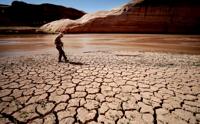
Frank Colver makes his way over the dried and cracking silt left where the Escalante River joins Lake Powell, Glen Canyon National Recreation Area, Utah. The receding water of the lake has the river cutting through the decades of accumulated silt to form a delta where it meets the lake.

A warning buoy sits high and dry far from the end of the closed public boat ramp at Bullfrog Bay, Glen Canyon National Recreation Area.

A line of tires that were once breakwaters at Bullfrog Bay Marina are now stranded on the rocky landscape high above the current water levels at the Glen Canyon National Recreation Area, Utah.
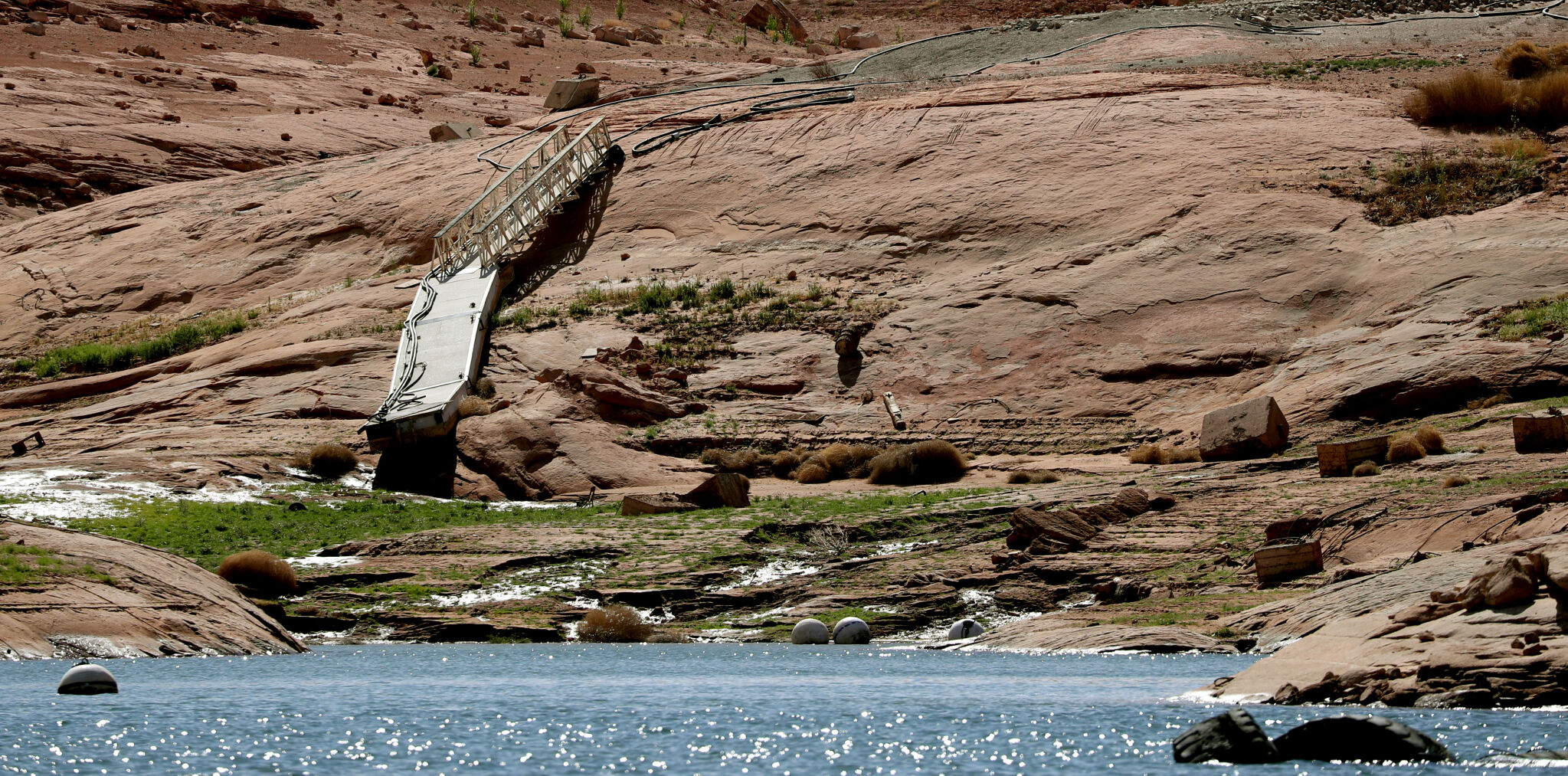
A pedestrian ramp lies well above the water levels at Bullfrog Bay in the Glen Canyon National Recreation Area, Utah.

A stranded wakeless zone buoy sits on the cracking silt outside the new shores of the Bullfrog Bay Marina, Glen Canyon National Recreation Area, Utah.

The end of the ferry ramp ends well short of the new water levels of Bullfrog Bay on the Glen Canyon National Recreation Area, Utah.

An early riser watches the sun come over the low waters of Bullfrog Bay Marina, Glen Canyon National Recreation Aria, Utah. The lighter colored areas on the canyon wall mark previous water levels.

A group of river rafters drift west on the current of the San Juan River outside Mexican Hat. The San Juan feeds Lake Powell.

The tops of a few cottonwood trees begin to poke out of shrunken water of Lake Powell, Fiftymile Creek, Glen Canyon National Recreation Area, Utah.

The remaining large water craft and house boats are crowded together in one of the last areas of water deep enough to support them at Wahweap Mariana, Glen Canyon National Recreation Area, Page, Ariz.

The waters of Lake Powell are twenty to thirty feet below the end of the public boat ramp at Wahweap Mariana, Glen Canyon National Recreation Area, Page, Ariz. Personal non-powered craft still use the ramp to unload, but must be carried up and down the banks to reach the water.
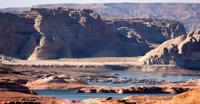
A view north from the Wahweap Marina Overlook show the shrunken waters around the marina in Glen Canyon National Recreation Area, Page, Ariz.

The underside of Gregory Natural Bridge, passable for the first time in almost 50 years, over the Fiftymile Creek, Glen Canyon National Recreation Area, Utah.

The moon rises over Gregory Natural Bridge, passable for the first time in almost 50 years, over the Fiftymile Creek, Glen Canyon National Recreation Area, Utah.

The exposed penstocks (intakes to the power turbines) on Glen Canyon Dam in the Glen Canyon National Recreation Area, Page, Ariz. The water level is at its lowest since 1967, when the dam was still being initially filled.

A group of sightseers get a look at the Glen Canyon Dam during a boat tour of Lake Powell, Glen Canyon National Recreation Area, Page, Ariz.

A small fishing boat ties up on the breakwater just outside the intakes for the Glen Canyon Dam, Glen Canyon National Recreation Area, Page, Ariz.. The penstocks (water intakes to the power turbines) are revealed for the first time since 1967 when the Lake Powell was being filled.

Swimmers and bathers use the jagged shores of the newly exposed banks of Lake Powell just above the Glen Canyon Dam, Glen Canyon National Recreation Area, Page, Ariz.

The Glen Canyon Bridge lies in front of electrical towers with feeder lines rising from the hydroelectric plant in the Glen Canyon Dam, Page, Ariz.

Glen Canyon Dam from Glen Canyon Bridge, Page, Ariz.

Small power boats on the Colorado River head upstream just below the Glen Canyon Dam, Page, Ariz.

Wade Quilter walks through the remains of cottonwood and Russian olive trees washed down and joined with silt to form a natural dam where Willow Canyon joins with the Escalante River, Glen Canyon National Recreation Area, Utah,

The remains of a big mouth bass lay in the silt just above where the Escalante River joins Lake Powell, Glen Canyon National Recreation Area, Utah.

The formation known as The Cathedral in the Desert on Clear Creek, Glen Canyon National Recreation Area, Utah. The re-emergence of the formation is drawing sightseers after being submerged for some 50 years.
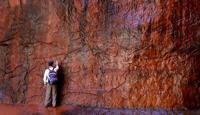
Tom Wright feels the water oozing from the rocks in the formation known as Cathedral in the Desert on Clear Creek, Glen Canyon National Recreation Area, Utah. The re-emergence of the formation is drawing sightseers after being submerged for some 50 years.

Frank Colver takes a quiet moment and plays a handmade flute near the waterfall in the formation known as Cathedral in the Desert on Clear Creek, Glen Canyon National Recreation Area, Utah. The re-emergence of the formation is drawing sightseers after being submerged for some 50 years.

Jake Quilter walks down the newly cut banks of Clear Creek just outside Cathedral in the Desert, Glen Canyon National Recreation Area Utah. The sand is silt left behind by the receding waters of Lake Powell.

The tops of cottonwood trees that used to be under a hundred feet of water in Lake Powell are visible again in Clear Creek, Glen Canyon National Recreation Area, Utah. The deep water preserved the remains of the trees.

Boaters have to zig-zag through the rocks emerging due to receding waters of Lake Powell, Glen Canyon National Recreation Area, Page, Ariz.

Several images combined for a panoramic view of the Colorado River where it runs through the what once was Hite Marina in the Glen Canyon National Recreation Area, Utah.

A couple of sightseers take in the view from Hite Overlook over the Colorado River and the closed Hite Marina, Glen Canyon National Recreation Area, Utah.
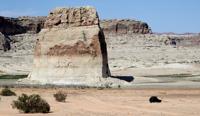
Lone Rock, jutting out of the dry bed, would usually be surrounded by Lake Powell but is now well clear of the water, Glen Canyon National Recreation Area, Utah.

Tires that used to hold the lines well below the surface of Lake Powell are suspended over the water at Antelope Point Marina, Ariz.
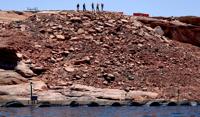
Sightseers twenty or thirty feet above get photos of the low water levels of Lake Powell from the public boat ramp at Antelope Point Marina, Ariz.

The pedestrian access ramp ends abruptly twenty feet over the new Lake Powell surface at Antelope Point Marina, Ariz.

The entrance to the pedestrian access ramp of the Antelope Point Marina is taped off after being cutoff from the docks due to receding waters of Lake Powell.
Longtime Arizona Daily Star reporter Tony Davis talks about the Colorado River system being "on the edge of collapse" and what it could mean for Arizona.



